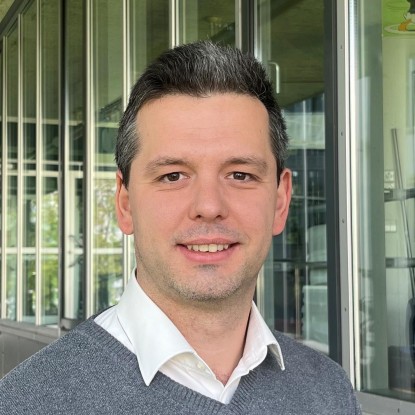Dr.-Ing. Guillaume Meyer
Kontakt
guillaume.meyer@tu-...
work 20554
fax 20555
Work
L2|01 54
Peter-Grünberg-Straße 2
64287
Darmstadt
Guillaume Meyer studied material engineering from 2005 to 2010 at the EEIGM (École Européenne d’Ingénieurs en Génie des Matériaux) in Nancy, France, and earned a French-German double master’s degree. Between 2010 and 2016, he worked as an aeronautical engineer for Airbus Operations in Hamburg, Germany, for his master thesis and as a subcontractor. He went back to university in 2017 and was employed as a research associate at the institute for Lightweight and Structural Mechanics (previously Lightweight Construction and Design) of the Technical University of Darmstadt, Germany. He worked on the implementation of carbon-fibre-reinforced plastic components in tooling machines and earned his Ph.D. in 2023 in the field of additively manufactured lattice lightweight structures. Since June 2024, he is working as post-doctoral research associate at the department of Physical Metallurgy of the Technical University of Darmstadt and investigates on the whisker phenomenon in the framework of the EU-funded project named LETTERSS (“Lead-Free Transition for the European Space Sector”, 101135428).
With the potential application of the Restriction of Hazardous Substances (RoHs) legislation to the aerospace industry, lead-free finishes cannot be avoided in electrical, electronic, and electromechanical parts. The main challenge of the Pb-free transition for the European Space Sector is to find lead-free alternatives that offer comparable or superior performance to Pb solders on a stable economic basis while being compliant with regulation requirements. The solution may lie in lead-free solders employed for terrestrial mass applications. Besides the difficulties of finding a mechanically reliable solder, metal whiskers are of concern. These crystalline filaments can grow out of the surface up to some millimeters and may lead to short circuits and other electrical failures in electronic components. In the context of a constant miniaturization trend in complex electronic assemblies, it is of utmost interest to prevent malfunction risks from whiskers. Industrial accelerated whisker testing procedures do exist, but they do not provide the ability to predict in-orbit service time. Neither correlations between test and field conditions nor reliable long-term predictions are available to this date. This means, by extension, that the space industry is lacking an accepted complete theory for both formation and growth on whisker under in-orbit conditions and has so far to proceed to risk management measures via mitigation for programmes where pure tin is accepted and for which the end customer is willing to accept the whisker risks. The main challenge encountered in the open literature is the lack of comparability between results and, hence, the difficulty to propose a universally valid whisker model. The developed step-by-step approach wants to address this lack of systematic parametric studies by proposing model experiments in which parameters can be changed independently of each other to replicate conditions under which the highest growth rates of whiskers are found. This approach should further identify and offer the possibility to control the driving parameters of both whisker nucleation and growth to make reliable predictions. The goal is to provide guidelines and propose whisker acceleration test conditions for future characterization and mitigation procedures for selected lead-free solders.

Fehler beim Laden der Daten
Beim Laden der Publikationsdaten von TUbiblio ist ein Fehler aufgetreten. Bitte versuchen Sie es zu einem späteren Zeitpunkt erneut.
-
{{ year }}
-
; {{ creator.name.family }}, {{ creator.name.given }}{{ publication.title }}.
; {{ editor.name.family }}, {{ editor.name.given }} (Hrsg.); ; {{ creator }} (Urheber) ({{ publication.date.toString().substring(0,4) }}):
In: {{ publication.series }}, {{ publication.volume }}, In: {{ publication.book_title }}, In: {{ publication.publication }}, {{ publication.journal_volume}} ({{ publication.number }}), SS. {{ publication.pagerange }}, {{ publication.place_of_pub }}, {{ publication.publisher }}, {{ publication.institution }}, {{ publication.event_title }}, {{ publication.event_location }}, {{ publication.event_dates }}, ISSN {{ publication.issn }}, e-ISSN {{ publication.eissn }}, ISBN {{ publication.isbn }}, DOI: {{ publication.doi.toString().replace('http://','').replace('https://','').replace('dx.doi.org/','').replace('doi.org/','').replace('doi.org','').replace("DOI: ", "").replace("doi:", "") }}, Offizielle URL, {{ labels[publication.type]?labels[publication.type]:publication.type }}, {{ labels[publication.pub_sequence] }}, {{ labels[publication.doc_status] }} - […]
-
Anzahl der Einträge in dieser Liste: >{{ publicationsList.length }}
Es werden nur die {{publicationsList.length}} neuesten Publikationen ausgegeben.
Vollständige Liste bei TUbiblio ansehen Diese Liste bei TUbiblio ansehen




